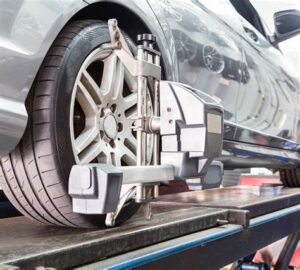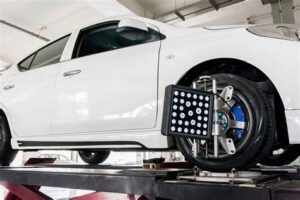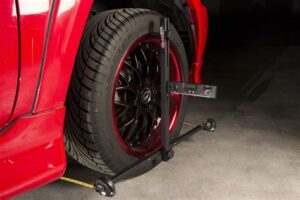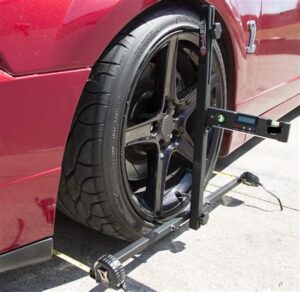Classic car enthusiasts know that preserving the charm and performance of their vintage vehicles requires a keen understanding of alignment specifications. Proper alignment is crucial for ensuring that classic cars not only look stunning on the road but also handle superbly. This comprehensive guide delves into the intricacies of classic car alignment, providing essential tools, step-by-step processes, and solutions for common issues. Whether you’re an experienced mechanic or a passionate hobbyist, mastering these alignment techniques can significantly enhance your classic car’s performance and safety. Join us as we explore everything you need to know about achieving the perfect alignment for your prized automobile.
Understanding Classic Car Alignment Specifications: A Comprehensive Overview
When it comes to maintaining a classic car, alignment specifications play a critical role in ensuring optimal performance and handling. Understanding these specifications can help you pinpoint adjustments needed for your vehicle.
Classic car manufacturers often set alignment parameters differently compared to modern vehicles. Key specifications typically include caster, camber, and toe settings. These angles dictate how the wheels are oriented in relation to the body of the car and the road.
- Caster: This is the angle of the steering axis from the vertical, viewed from the side of the vehicle. A positive caster angle promotes stability, especially at higher speeds.
- Camber: This angle measures how much the wheels tilt inward or outward when viewed from the front. Proper camber ensures even tire wear and improves cornering ability.
- Toe: This refers to the direction the wheels point relative to the centerline of the car. Toe-in means the front of the wheels is closer together than the back, while toe-out is the opposite. Accurate toe settings enhance steering responsiveness and tire lifespan.
It’s essential to consult owners’ manuals or service manuals specific to your classic car model for precise alignment figures. Each vehicle may have its unique tolerances based on its suspension system and design. Adhering to these specifications is crucial not just for performance, but also for maintaining the car’s value.
By understanding these fundamental alignment specifications, classic car enthusiasts can ensure their vehicles handle better and deliver a smoother ride. This not only enhances vehicle performance but also contributes to a safer driving experience.
Essential Tools for Classic Car Alignment: What You Need to Get Started
When it comes to achieving precise alignment for your classic car, having the right tools is essential. Below, we outline the key instruments you’ll need to ensure an effective alignment process.
- Alignment Rack: This is the foundation of any alignment setup. It allows you to raise the vehicle and provides a flat surface to measure angles accurately.
- Camber Gauge: A vital tool for measuring the camber angle of the wheels. Accurate camber alignment helps ensure even tire wear.
- Toe Gauge: To measure the toe angle, this tool helps to ensure that your wheels are parallel, which is crucial for steering control.
- Caster Tool: Used to measure the caster angle, this tool ensures your wheels are positioned correctly for better handling.
- Leveling Tools: A good level can help you ensure that your alignment rack is perfectly horizontal, essential for obtaining accurate measurements.
- Wrenches and Sockets: A complete set allows for adjustments to various suspension components easily.
- Torque Wrench: Ensuring that you tighten bolts to the manufacturer’s specifications is critical to maintaining the integrity of your classic car.
- Turn Plates: Useful for measuring the steering angles during the alignment process.
- Measuring Tape: A simple yet effective tool to measure distances and ensure that everything is aligned to the correct specifications.
- Notebook or Digital Device: Keeping track of measurements and adjustments is key to achieving and maintaining proper alignment.
Equipped with these essential tools, you’ll be on your way to effectively aligning your classic car, ensuring optimal performance and safety on the road.
Step-by-Step Process for Aligning Classic Cars: Tips for Success
Aligning a classic car requires precision and an understanding of the vehicle’s unique specifications. Here’s a detailed step-by-step guide to ensure your alignment process is successful:
- Gather the Necessary Tools: Before you start, make sure you have all the essential tools at hand, such as a camber gauge, alignment shims, a toe gauge, and a reliable jack.
- Check Tire Condition: Inspect the tires for uneven wear and proper inflation. This ensures that you are starting with a stable foundation for alignment adjustments.
- Measure Ride Height: Use a tape measure to assess the ride height of the vehicle. Adjust the height if necessary to meet the manufacturer’s specifications.
- Set Camber Angles: Adjust the camber angles to the desired specifications using your camber gauge. Check both the front and rear wheels for accuracy.
- Adjust Caster Angles: Caster angles can affect steering and handling; ensure they meet the classic car specifications. Adjust as needed for optimal performance.
- Align the Toe: Use a toe gauge to ensure that the front wheels are parallel. Adjust the tie rods accordingly to achieve the correct toe settings.
- Test Drive: After making all adjustments, take the classic car for a test drive. Pay attention to any pulling or steering issues, as they may indicate further adjustments are needed.
- Double-Check Measurements: Once back from the test drive, re-measure all angles and make sure everything is within the recommended specifications.
- Maintain Records: Keep detailed records of the alignment specifications and any adjustments made. This will help in future alignments and troubleshooting.
By following these steps for aligning your classic car, you’ll ensure improved handling, safety, and performance on the road. Regular alignment checks are essential to maintaining the integrity and longevity of your vehicle.
Common Alignment Issues in Classic Cars: Causes and Solutions
Classic cars, while beloved, often present unique challenges when it comes to alignment. Several common issues can arise that affect the vehicle’s performance, handling, and safety. Here’s a closer look at these issues, their causes, and effective solutions.
1. Uneven Tire Wear
One of the most noticeable signs of alignment problems in classic cars is uneven tire wear. If the tires show excessive wear on one side, it may indicate misalignment.
Causes: This issue can stem from incorrect camber settings or poor suspension components.
Solutions: Regularly inspect your suspension and tires, and ensure your classic car’s alignment is adjusted properly to manufacturers’ specifications. Replacing worn parts can also help restore even wear.
2. Pulling to One Side
If your classic car consistently drifts to the left or right while driving, it’s a clear indicator of alignment issues.
Causes: This problem can occur due to uneven tire pressure or improper alignment angles.
Solutions: Check and adjust tire pressures, and have a qualified technician assess the alignment to correct any deviations.
3. Steering Wheel Off-Center
A steering wheel that isn’t centered when driving straight is another common issue in classic cars.
Causes: This misalignment often results from changes in suspension geometry or improper caster settings.
Solutions: A professional alignment service can readjust the suspension components to correct the steering wheel’s position.
4. Vibration in the Steering Wheel
If the steering wheel vibrates, especially at higher speeds, it’s an indication that your classic car’s alignment may be off.
Causes: This may be caused by misaligned wheels or unbalanced tires.
Solutions: Balancing the tires often alleviates this issue, along with ensuring proper alignment is in place.
5. Shortened Tire Life
Misalignment can lead to significantly reduced tire life, which is a cost concern for classic car owners.
Causes: Similar to uneven tire wear, incorrect alignment angles can accelerate tire degradation.
Solutions: Regularly checking alignment and tire conditions can help ensure that tires perform optimally for longer periods.
Assessing and addressing these common alignment issues in classic cars is crucial for preserving the vehicle’s performance and ensuring a smooth driving experience. By keeping a close eye on these symptoms and promptly addressing them, classic car owners can enjoy their vehicles while maintaining safety and handling precision.
Benefits of Proper Classic Car Alignment: Enhancing Performance and Safety
Proper alignment is crucial for maintaining the performance and safety of your classic car. Here are some key benefits of ensuring your vehicle’s alignment is spot on:
- Improved Handling: Correct alignment ensures that your classic car responds as intended to steering inputs, providing a smooth and controlled driving experience.
- Increased Tire Life: When wheels are aligned properly, it reduces uneven tire wear, extending the lifespan of the tires and saving you money in replacements.
- Enhanced Fuel Efficiency: A well-aligned classic car minimizes rolling resistance, leading to better fuel economy—an essential factor for long drives and show events.
- Safety: Misalignment can lead to compromised stability, which could increase the risk of accidents. Proper alignment contributes to better braking and stability under various driving conditions.
- Preservation of Suspension Components: Regular alignment helps prevent excessive wear on suspension parts, allowing your classic car to maintain its vintage charm and functionality.
Caring for your classic car through proper alignment not only enhances performance but also ensures safety on the road, making it a vital aspect of classic car maintenance.
Frequently Asked Questions
What are classic car alignment specifications?
Classic car alignment specifications refer to the precise angles at which a vehicle’s wheels are set to ensure optimal handling, tire wear, and performance.
Why is proper alignment important for classic cars?
Proper alignment is crucial for classic cars as it enhances stability, improves fuel efficiency, and increases tire lifespan, which is particularly important for preserving vintage vehicles.
How can I tell if my classic car needs an alignment?
Signs that your classic car may need an alignment include uneven tire wear, pulling to one side while driving, a crooked steering wheel, or a vibration in the steering wheel.
What factors can affect alignment specifications for classic cars?
Factors that can affect alignment specifications include suspension wear, changes in ride height, tire pressure, and modifications made to the vehicle.
Can I align my classic car myself?
While basic alignment can be attempted at home with the right tools and knowledge, it is advisable to have a professional perform the alignment to ensure accuracy, particularly for classic cars with unique specifications.
What tools do I need for a classic car alignment?
Tools needed for a classic car alignment often include a tape measure, camber gauge, caster angle gauge, leveling tool, and possibly a string alignment tool for precision.
Where can I find alignment specifications for my classic car model?
Alignment specifications for classic car models can often be found in the vehicle’s service manual, online forums, or by contacting classic car restoration experts.





